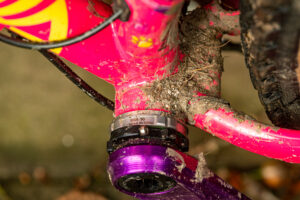Aplina's debut full-face MTB helmet is a reasonable effort.
Alpina Roca helmet review
This Alpina Roca is the German brand’s first shot at producing one of the best full-face mountain bike helmets. It is focussed on lightweight and ventilation, meaning it’s more aimed at enduro and e-bike riders looking for extra coverage than full-on downhill racers or bike park season pass holders. That said, protection levels here are still fully DH certified and the chin strap fastens with double D rings that are usually found on DH and MX helmets. As such they’re fiddlier to fasten but more secure.
The Roca’s styling is very contemporary with clean lines and sharp edges, which makes a change from the more common organic or curvy shapes. It sits in place with a slimline profile once on the head, and I reckon it looks bang-on.
The outer shell uses an in-mould construction, which fuses a polycarbonate outer layer to a polystyrene shock-absorbing inner, which the brand says has ‘multiple microscopic air chambers’ for optimum impact protection. Surely that’s what expanded polystyrene has by definition anyway, isn’t it? There is no additional protection technology to combat rotational impacts such as MIPS or one of the other slip-plane or ‘twist’ technologies. Alpina also doesn’t make any claims about different densities in the EPS layer to absorb impacts of varying velocities that lots of other brands do.

Alpina Roca Helmet
The slightly more stripped back feature list does result in a cheaper asking price (currently reduced from £180) than some rivals, and one area Alpina doesn’t scrimp on is the sizing. Unlike its rather limited full face lids, the Roca comes in four sizes and includes two sets of antibacterial pads included to ensure a good fit. And it’s a good thing, as there’s no cradle or retention dial. Instead, Alpina relies on on the different sizes and an (effective) thicker pad at the nape of the neck to keep the lid stable.
Trail visibility is excellent when wearing the Roca – there’s a really big window between the brow and chinbar to see far ahead and to the sides and also loads of room for goggles (they also sit at the right angle). Cooling is really good on the face and around the ears, although I did find the top and back of my head got really warm on climbs. The padding inside is pretty continuous and wraparound on the scalp, so there’s less air flow inside and there also aren’t as many vent ports higher up the lid as some lids. The helmet is generally comfy and stays stable, but I did have a pressure point on my ears where the padding was compressed – I’d like to see a larger recess here.
Verdict
The Roca is a fair bit heavier than many similar lightweight full-face helmets such as the Troy Lee Designs Stage, Fox’s Proframe and the similarly stripped-back DH certified iXS Trigger FF (over 150g lighter and noticeably airier). All this means that, while the Alpina Roca is a reasonable option, I can’t really recommend it above and beyond its more established rivals.
















